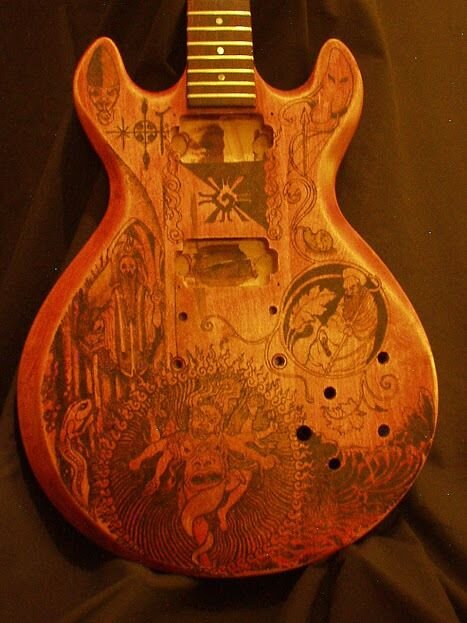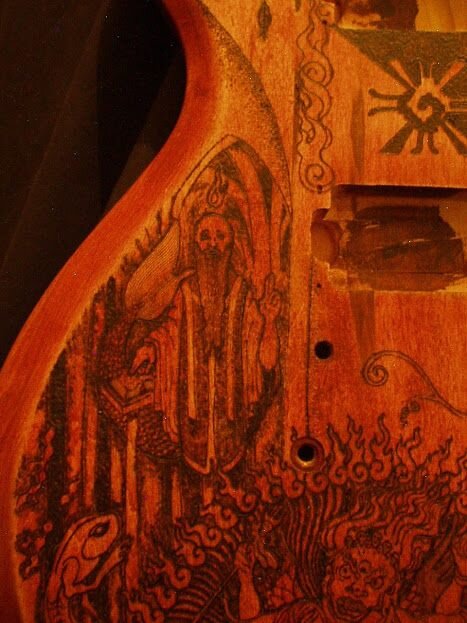Twain- Tongues of Flame #2
Twain
This guitar is one of my finest works, and the symbolism involved could spawn a book-length commentary, but for the sake of both the client’s privacy and the viewer's patience, I'll keep it brief. The guitar is a meditation on the nature of loyalty and division, and on the nature of sacrifice.
The lower half-front of Twain, or Beyond the Between… The upper front half of Twain: Choices.


















Pictured here are Eshu Ellegua and the Veve of Legba. Integrity without understanding is not enough. This component represents the limits of righteousness, the ambiguity of all merely human perceptions.
Perhaps the most famous Yoruba story about Eshu concerns two inseparable friends who swore undying fidelity to one another but neglect to acknowledge Eshu. These two friends work on adjacent fields. One day Eshu walks on the dividing line between their fields, wearing a cap that is black on one side and red (or white) on the other. He saunters between the fields, exchanging pleasantries with both men. Afterwards, the two friends got to talking about the man with the cap, and fall to violent quarreling about the color of the man's hat, calling each other blind and crazy. The neighbors gather about, and then Eshu arrives and stops the fight. The friends explain their disagreement, an Eshu shows them the two-sided hat--all this to chastise the friends for not putting him first in their doings. The lesson of the tale is obvious, but just as interesting is where it places the god. Moving along the seam between two different worldviews, he confuses communication, reveals the ambiguity of knowledge, and plays with perspective.--http://www.levity.com/figment/trickster.html
The hood pictured here, with the emblems of Ochosi the Hunter may be perceived either as retributive vengeance and the persistence of evil (i.e., the hood of a night-rider or klansman), or it may represent the regret and empathy of the penitente, or the designation of a heretic as the enemy of received truth. In all three aspects, it calls us to consider the question of what we owe the past.
The central emblem is the Hunab Ku/Mantle of Lip Plugs, used here as an emblem of dynamic balance between opposing forces.
The lower right panel of the Guitar represents Jonah under the Gourd Vine, a story about the limits of human empathy vs. Divine Grace. The Division of the Waters (Genesis 1:7). Sometimes division creates the space for life, and we are made whole by our woundedness.
The Fierce Deities of the Between drive the soul toward incarnation, toward choice, action, consequence and rebirth, away from the limbo of the indeterminate state. They are the metaphysical equivalent of quantum collapse, the moment at which Schrodinger's cat must become either alive or dead.
The price of evolution: growth requires change, and all change is a loss of some kind. Life requires an endless willingness to die again and again.
Proteus ex cathedra. Proteus of Greek mythology, the great shape shifter, is presented here as an anointed apostle, crowned with the kergyma of the Holy Spirit. Ambiguity and diversity may serve as instruments of Grace.
The back: Offerings and Victims. The back of the guitar contrasts the image of Christ with that of the Hanged Man of Tarot symbolism, here a portrait of Prometheus bound. Christ is here depicted in the tradition of Catholic Spain, crucified against a human heart. The Eagle behind him is formed of lung tissue, and represents the "Blood Eagle" sacrifice of Norse tradition, a savage expiation of guilt. Prometheus is depicted here as the hanged man, the victim who is powerless, suspended between possibilities. Perched above him is the vulture who gnaws continuously on his liver, while he himself is suspended from the spine as the axis mundi, the ribs of which provide the structure of the vesica piscis in which he is enclosed.
Nidhrogger, the dragon that gnaws at the root, here presented in gold as mortality lurking in the viscera. The Norns, or Fates (Past, Present and Future) who represent the destinies against which we act out our choices. Hela as Lilith.
The entire back of the guitar represents the human body as the World Tree. Poised in balance between the omnipotent vulnerability of Christ and the impotent immortality of Prometheus is Ratatosk, the Squirrel, who carries messages from the Dragon at the roots to the Eagle at the Crown.
